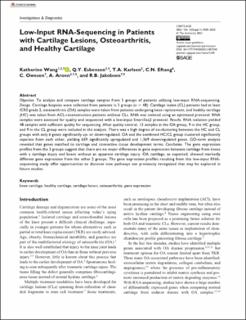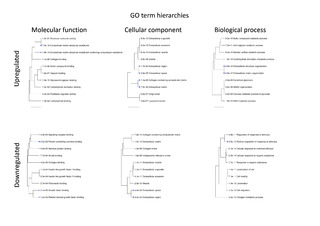| dc.contributor.author | Wang, Katherine | |
| dc.contributor.author | Esbensen, Qin Ying | |
| dc.contributor.author | Karlsen, Tommy Aleksander | |
| dc.contributor.author | Eftang, Cathrine Nørstad | |
| dc.contributor.author | Owesen, Christian | |
| dc.contributor.author | Årøen, Asbjørn | |
| dc.contributor.author | Jakobsen, Rune Bruhn | |
| dc.date.accessioned | 2022-03-10T13:57:03Z | |
| dc.date.available | 2022-03-10T13:57:03Z | |
| dc.date.created | 2021-11-17T10:21:47Z | |
| dc.date.issued | 2021 | |
| dc.identifier.citation | Cartilage. 2021, 13(Supplement 1), Side 550S-562S. | en_US |
| dc.identifier.issn | 1947-6035 | |
| dc.identifier.uri | https://hdl.handle.net/11250/2984337 | |
| dc.description | This article is distributed under the terms of the Creative Commons Attribution 4.0 License (https://creativecommons.org/licenses/by/4.0/) which permits any use, reproduction and distribution of the work without further permission provided the original work is attributed as specified on the SAGE and Open Access page (https://us.sagepub.com/en-us/nam/open-access-at-sage). | en_US |
| dc.description.abstract | Objective
To analyze and compare cartilage samples from 3 groups of patients utilizing low-input RNA-sequencing.
Design
Cartilage biopsies were collected from patients in 3 groups (n = 48): Cartilage lesion (CL) patients had at least ICRS grade 2, osteoarthritis (OA) samples were taken from patients undergoing knee replacement, and healthy cartilage (HC) was taken from ACL-reconstruction patients without CLs. RNA was isolated using an optimized protocol. RNA samples were assessed for quality and sequenced with a low-input SmartSeq2 protocol.
Results
RNA isolation yielded 48 samples with sufficient quality for sequencing. After quality control, 13 samples in the OA group, 9 in the HC group, and 9 in the CL group were included in the analysis. There was a high degree of co-clustering between the HC and CL groups with only 6 genes significantly up- or downregulated. OA and the combined HC/CL group clustered significantly separate from each other, yielding 659 significantly upregulated and 1,369 downregulated genes. GO-term analysis revealed that genes matched to cartilage and connective tissue development terms.
Conclusion
The gene expression profiles from the 3 groups suggest that there are no major differences in gene expression between cartilage from knees with a cartilage injury and knees without an apparent cartilage injury. OA cartilage, as expected, showed markedly different gene expression from the other 2 groups. The gene expression profiles resulting from this low-input RNA-sequencing study offer opportunities to discover new pathways not previously recognized that may be explored in future studies. | en_US |
| dc.language.iso | eng | en_US |
| dc.subject | cartilage lesion | en_US |
| dc.subject | gene expression | en_US |
| dc.subject | healthy cartilage | en_US |
| dc.subject | knee cartilage | en_US |
| dc.subject | osteoarthritis | en_US |
| dc.title | Low-input RNA-sequencing in patients with cartilage lesions, osteoarthritis, and healthy cartilage | en_US |
| dc.type | Peer reviewed | en_US |
| dc.type | Journal article | en_US |
| dc.description.version | publishedVersion | en_US |
| dc.rights.holder | © The Author(s) 2021 | en_US |
| dc.source.pagenumber | 550S-562S | en_US |
| dc.source.volume | 13 | en_US |
| dc.source.journal | Cartilage | en_US |
| dc.source.issue | Supplement 1 | en_US |
| dc.identifier.doi | 10.1177/19476035211057245 | |
| dc.identifier.cristin | 1955451 | |
| dc.description.localcode | Institutt for idrettsmedisinske fag / Department of Sports Medicine | en_US |
| cristin.ispublished | true | |
| cristin.fulltext | original | |
| cristin.qualitycode | 1 | |

